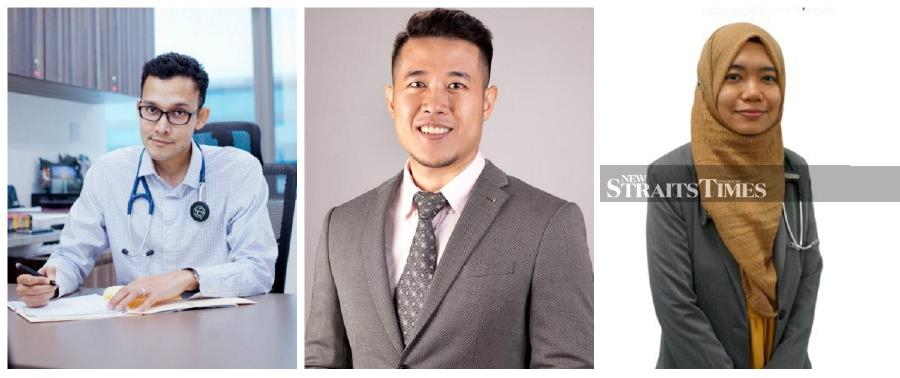
(From left) Professor Dr James Koh, Dr Ashok Philip and Datuk Dr Kuljit Singh

(From left) Dr Helmy Haja Mydin, Dr Ernest Poh and Dr Nurul Yaqeen Mohd Esa.
Source from NST online: https://www.nst.com.my/news/nation/2020/04/585124/can-downward-trend-remain
KUALA LUMPUR: WITH fewer than 100 cases of Covid-19 recorded on Wednesday, it seems like a downward trend is finally emerging in the number of infections in the country.
But does this mean it’s time to ease some of the restrictions of the Movement Control Order (MCO), particularly in areas classified as green zones where infection rates have remained low?
And at the end of the MCO, what measures or level of normalcy should residents in these places expect?
The Malaysian Health Coalition (MHC), an apolitical coalition of professional health societies, health professionals and citizens dedicated to improving the health of Malaysians and strengthening the Malaysian health system, on Wednesday called for guidelines based on a colour-coded zoning system, where residents and businesses in green zones, for example, have looser restrictions than those in yellow and red zones.
While the drop in new reported cases to double digits for the first time is a much awaited and welcomed news, the next few days or weeks will show whether this downward trend can be sustained, said International Medical University’s School of Medicine consultant infectious disease specialist and associate dean of academic affairs Professor Dr James Koh.
“Zonal easing of restrictions, particularly in zones which have not had new cases reported for the past two weeks, might be a good strategy to consider to allow normalcy to return and affected businesses to recover.”
However, this must be done with proper guidelines, including maintaining the practice of social distancing, good hand hygiene, the wearing of masks.
Internal medicine specialist with a special interest in respiratory medicine at Mahkota Medical Centre, Dr Ashok Philip, suggested that solitary outdoor workouts be allowed in green zones.
Shops, he said, could open, but with strict guidelines on how many people could enter at one time, depending on the size of the shop.
“Sanitisers should be provided and the use of masks encouraged.”
Restaurants, however, should continue to avoid dine-in and no shops or services that required close physical proximity or contact should be opened, he added.
Consultant otolaryngologist and Prince Court Medical Centre medical director Datuk Dr Kuljit Singh said it was imperative to remember that a decrease in the number of cases and the easing up of the MCO did not mean Covid-19 has ended.
Hence, it is crucial that social distancing be maintained for a longer period of time.
Citing the example of loosening restrictions and allowing people to exercise in public, he said once this was allowed, it would be tough to control and police the number of people outside.
“At this point in time, we do not want to be creating more clusters as there could be many asymptomatic patients. Therefore, even after the MCO has been lifted, people should wait a little longer before exercising in public.”
Pantai Hospital Kuala Lumpur respiratory physician Dr Helmy Haja Mydin also said social distancing should remain and that any premature easing of restrictions for social reasons ran the risk of reversing all that we have achieved so far.
He said the focus of easing restrictions should be based on both public health and socioeconomic reasons. The first step would be to identify industries or sectors and employers within green zones that have suitable business continuity plans and closely monitor the impact of opening up these segments.
“We will have to open up the economy bit by bit; it’s not an all-or-none situation.”
University Malaya Specialist Centre consultant respiratory physician Dr Ernest Poh said by allowing people back onto the streets and shops to open, the herd mentality would be that the crisis was over.
And with festivities fast approaching, shops that are open will soon be crowded with people. People may also cross from red zones to reach shops in green zones that are open to purchase goods.
“Sure, you may have some good and vigilant citizens who obey rules of social distancing, but they, too, may become careless with time.
“Take for example, the crowds that thronged the shops at Little India, Brickfields recently. You cannot expect the police to be everywhere. New clusters will then start to develop within the green zones.”
Regency Specialist Hospital respiratory medicine and internal medicine specialist Dr Lucas Wee Jee Koon said it was reasonable for people in green zones to be out exercising in parks while adhering to strict social distancing.
“That means exercising solo. It’s good for health without bearing the risks of getting infected.”
He cited the experience of Taiwan, which has kept people with risk factors like travel history to affected areas or countries, or close contact with infected people, strictly quarantined but at the same time, allowed those who were healthy or without contact history to contribute economically.
On the downside, if people did not abide by strict social distancing rules, then Covid-19 would continue to spread, he said.
“Public discipline should be observed in order to prevent a resurgence. In Singapore for example, stern law enforcement has ensured strict discipline. So, let us do our part.”
Any easing or lifting of MCO restrictions should only be done after confirming the status of a green zone by doing random sampling and testing based on population demographics, said Sunway Medical Centre Velocity consultant respiratory and internal medicine physician Dr Nurul Yaqeen Mohd Esa.
“By doing so, even carriers can be ruled out. If they have the antibodies (IgG positive) against Covid-19, and they don’t have symptoms then they should be safe.
“PCR testing for all symptomatics and antibody testing for asymptomatics in clusters or communities where a positive case has been identified should be done before the lifting of the MCO.”

